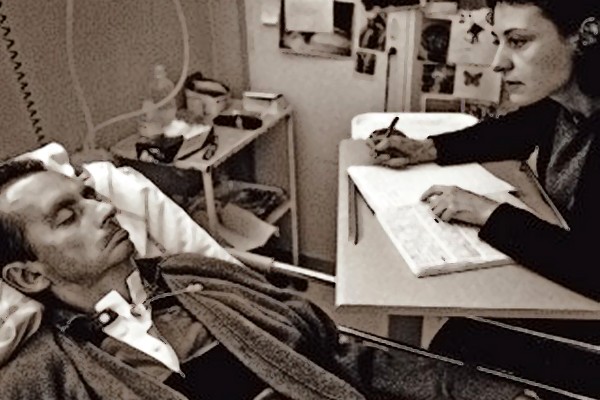Becoming Human

By: Erica Lee
“E. S. A. R. I. N—“
Lying prone in a hospital bed, Jean-Dominique Bauby blinked his left eye.
N.
His attendant wrote the letter and continued reciting their reordered alphabet.
“E. S. A—”
He blinked.
A.
And in this fashion, Bauby dictated The Diving Bell and the Butterfly. In this memoir, Bauby chronicled his life before the stroke that locked him in his own body as well as the struggles and triumphs he experienced afterwards as a paralyzed man.
In Illness as Metaphor, Susan Sontag describes the relationship between health and disease like holding “a dual citizenship, in the kingdom of the well and in the kingdom of the sick.”

Photo Credit: Wikimedia Commons
Bauby’s stroke threw him head first into the kingdom of the sick—a strange, illogical place for someone who spent his days as an energetic journalist, fiery writer and editor for Elle magazine, father to two beautiful children and partner to a loving woman. His stroke locked him in his body, but his writing set him free.
Like Bauby, countless others have used art to help them understand, explore and express their personal experiences with disease and death. Art, in any form, is often crucial for individuals to understand their new reality.
Frida Kahlo, the famous surrealist painter, had spina bifida, a condition in which the vertebrae around part of the spine fail to form, leaving the spine unprotected and easily damaged. Her delicate spinal cord jostled and stung with every step and movement, sending daggers down her lower half. Ulcers that formed and festered in her legs and feet drove her to undertake over thirty surgeries. When these failed to alleviate her excruciating, daily pain, she turned to art. “I paint because I need to,” she said. Her works portray her flawed spine as a broken pillar. Another painting is a detailed study of the excruciating sores between her toes. Kahlo used art to escape her painful reality, trading her imperfect, diseased body for something perfect and immaterial. “Feet, what do I want them for,” she wrote, “when I have wings to fly?”
When faced with blindness, writer and poet Emily Dickinson despaired that she would no longer know the written word, what she called “the strongest friend of all.” In “My First Well Day—Since Many Ill” she seems to come to terms with blindness. She writes:
“My loss, by sickness—Was it Loss?
Or that Ethereal Gain
One earns by measuring the Grave—
Then—measuring the Sun.”
Throughout history, humans have used art to help themselves understand events that radically alter their lives, from falling in love to experiencing war, genocide and disease. Patients recovering from all sorts of illnesses and disorders enjoy all kinds of benefits from art therapy. When individuals with severe dementia lose their capacity for speech, they often find their inner voice when creating art. Creation allows them to continue to stimulate their entire brain and stave off the usually-irrevocable and rapid decline in neurological function. Visualizing their finished goal stimulates the temporal lobe, and physically manipulating paint or sculpture works their fine motor skills. Even simply viewing paintings often alleviates depressive symptoms and increases sociability.
One woman’s accident had left her paralyzed from the waist down. Now in her fifties, this woman had once been a painter, and her lack of mobility made her frustrated. Eventually, she was labeled a “problem” patient. During one of the “creative encounters” programs, a volunteer asked the woman if she would tell him what to paint. The woman relaxed. Giving her a medium to work with, even through another person, “really turned around the situation,” said the volunteer. “The next day she was a new person.”
Art can help patients who live with debilitating diseases understand its place in their lives. However, patients are not the only ones who turn to art to help them understand life-altering diseases. Physicians and other healthcare professionals step into the kingdom of the sick every day and often leave feeling emotionally drained. Many physicians have also become writers to help them understand both the disease they treat and the patients they encounter. In his Pulitzer Prize-winning book The Emperor of All Maladies, oncologist Dr. Siddhartha Mukherjee explored the history of cancer, a malicious, indestructible force throughout history.
Often, individuals turn toward art to strengthen themselves against the thought of death or a handicapped life and to ward away the thoughts that it was their own body that betrayed them. Art is a crucial aspect of life for anyone who deals with disease and death, whether they use it as an escape from the harsh realities of illness and its treatment or to help them understand it better and accept it as part of their lives. Most importantly, it gives them hope–the greatest medicine.
